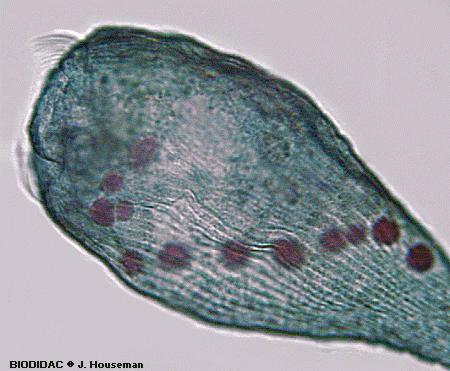In majors Biology lab last week we (un)covered the protists. One of the many living critters we looked at was Stentor. How is it that I have managed to know so little about such an amazing Genus? I should have had students take videos, but the actual oohs and ahhs from students seemed enough at the time. Here is one off youtube:
If you aren’t impressed: these are giant one-celled creatures that can be up to 1mm long. In fact, they are clearly bigger than the rotifers we also saw in these cultures, and those are (admittedly small) ANIMALS. Single celled organism that is bigger than a multicellular animal with a mouth, intestines, anus, nerves, eyespots & other ORGANS. No?
Let’s try this: when they aren’t hunting around for food (in ponds, Stentor are normally found in freshwater ponds) they hold on to something and extend out to look like a trumpet:
Not impressed? They have fibers inside them that run the length of the cell that allow them to contract very quickly (they can contract themselves much faster than your muscle cell). It looks like they aren’t made of the fiber systems we know about in all other cells (microtubules or actin). Stentor has both microtubules and actin, its just that these don’t appear to be made of them.

See those purple-ish spots? Those are its nucleus (it has several actual), which is pinched off into little balls. If you cut this cell into pieces, each piece will regenerate a whole cell identical to the original. Scientists in 1896 discovered that, as long as the fragments were bigger than 70-80 microns in diameter, they could regenerate the whole cell. Your cells don’t do that. There is a lot of “How in the HELL does it pull THAT off?”. For instance: how is it that the cytoplasm doesn’t leak out all over the place?

A piece of Figure 33 (in the subsection “Minced Stentors”) of The Biology of Stentor, Vance Tartar (1961)
Its both sad and wonderful that Stentor is understudied. Sad because there is so much to be learned by looking at organisms distantly related to us, but because these don’t cause disease in humans or food crops there is very little grant money to study them. Wonderful because science requires ignorance. Finding interesting ignorance that is accessible to students can be difficult sometimes, but in this case its right out there in a scoop-full of pond water.
_____
The Biology of Stentor, Vance (1961)
Marshall Lab website (UCSF)
Stentor coeruleus. Slabodnick et al Current Biology 2014


